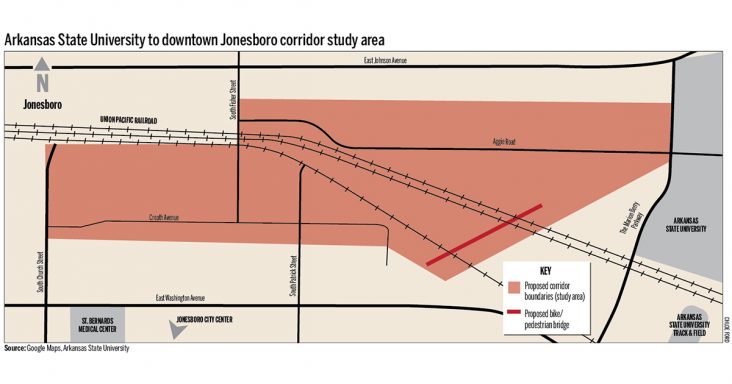Committee studying possible ASU to downtown Jonesboro corridor
by October 2, 2018 5:00 pm 869 views

Northern Jonesboro is perhaps the most blighted part of the city, and civic and business leaders are exploring what impacts may result from a corridor between the Arkansas State University campus and the city’s downtown.
The city has formed an 11-member Downtown Corridor Committee to study the issue, Chairman Mike Downing told Talk Business & Politics. The goal is to study the issue from every angle and present a recommendation to the Jonesboro City Council in the coming months.
How long it will take isn’t known, but a corridor along a 2.5-mile stretch could be vital in the resurrection of the area’s economy, said Downing, who is also the vice president of economic development for Jonesboro Unlimited. The committee will also make a recommendation about what to do with the former Wolverine property, located in the area and now owned by the city.
“That is one of the key objectives,” Downing said of economic revitalization. “We’ve got a lot of hurdles to overcome.”
Jonesboro Mayor Harold Perrin told Talk Business & Politics that every strategic development study about the city during the past 40 years mentioned a corridor. The committee began as one whose purpose was to determine what to do with the Wolverine property that was donated to the city. While studying the issue, Downing suggested the committee’s objective be broadened to include the corridor, Perrin said.
“This is the perfect set of people,” Perrin said. “They represent all interests of this area, and I look forward to what this committee recommends to our city council.”
The first step in building a corridor is the construction of a proposed bike path along the route, Downing said. It would be the first part of a proposed beltway that would loop around the entire city. It would connect downtown with ASU, Craighead Forest Park and other city points of interest. It would have beltways to interconnect around the city. The bike trail is probably too long for students to walk downtown, he said. He doesn’t know how that issue will be resolved.
Most colleges and universities are within walking distance of the downtown area in the cities in which they are located, Downing said. The former Wolverine property isn’t directly on the proposed route. What could be done with that property is uncertain. Development has been a “hodge podge” during the past 25 years, and there will be zoning issues to address, he said.
How much the bike trail will cost and how it will be paid for are elements being studied, Downing said. The route is fraught with zoning, street access, safety and other issues that will have to be studied, he said. The committee has had a handful of meetings, and the main thrust now is to generate as much data as possible, he said.
Public-private partnerships could be explored. State and federal grants and other funding sources could be sought once a plan is formulated, Downing said. Downtown development will not only enhance the immediate area, but it will also be a tool the city can use to attract young professionals. Quality of life is a key consideration, he said.
Jonesboro Unlimited was formed in 1986 to advance economic development in Jonesboro and Northeast Arkansas. It completed its fundraising for its latest economic development project “Momentum Jonesboro,” to create jobs and boost incomes. It raised about $3.6 million to execute the five-year job development plan. Downing, former director of the Missouri Department of Economic Development, was hired as part of the Momentum plan.
Putting a plan into action will be important in business recruitment, Downing said. Locating a major job producer in that part of the city would be transformative, he said. Many businesses and industries want to locate in places with a vibrant downtown, he said. Visual appeal, safety and street access to the corridor will be considered by many job creators.
Downing was a part of a project to lure the National Geospatial Intelligence Agency (NGA) to northern St. Louis when he worked in Missouri. That part of the city was blighted, Downing said. Missouri leaders were able to convince the NGA there was a solid plan in place to develop that part of the city, and it decided to build a facility there, Downing said. It was a $1.7 billion project and created 3,400 jobs, he added.
Another downtown project city leaders have eyed that could spur walking traffic is a downtown interactive museum. It will cost about $8 million, according to estimates. Any museum in downtown would also have to be a public-private partnership, leaders have said.
The first step is to acquire a building for the museum. The city and the Union Pacific Railroad have had discussions about a railroad roundhouse owned by the railroad. Jonesboro Community Director Tiffny Calloway said she is hopeful the company will donate the 23,000-square-foot building, but the city might consider paying for it.
Delta Center for Economic Development Interim Director Andrea Allen is an ASU graduate, and a corridor connecting the campus to the downtown would have been heavily utilized when she was in school, she told Talk Business & Politics. Allen is also a member of the Corridor Committee. Increased foot and bike traffic on that route will enhance retail possibilities, she said. It will take months to formulate a plan, but it will likely take years to implement it, she said. But it will be a boon to the city’s quality of life and economy, she added.
“We want to figure out what is best for Arkansas State University and what is best for the city,” she said.
